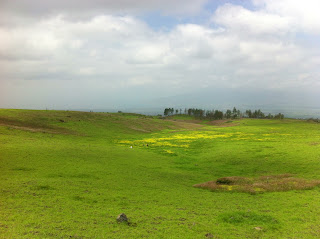Just mauka of Malu Ulu Olele Park in Lahaina is Waiola Church. Originally known as Waine'e Church. The boundary of the cemetery and the park are hard to exactly determine. As Mr. Kapu told me, that when the park was being cleared. Iwi were found just a few feet underground beyond the cemetery toward the ocean. All clean up under the surface was halted.
Like the royal burials in Pohukaina on the Iolani Palace grounds were moved to Mauna Ala in the Royal Mausoleum on Oahu. Moku'ula burials were transported to Waiola cemetery. Luckily, not quite as distant as it was on Oahu. Some legends exist about exactly who was buried at Moku'ula and some are left to mystery.



Kamehameha's wives Kaahumanu and Keopuolani had sway over the Hawaiian people after the passing of their husband. Together they set the ground work for the Hawaiian people converting to Christianity over that of the ancient Hawaiian gods and kapu that restricted much of the population. During the rule of Kamehameha II they enacted the Ai'noa, abolishing the Kapu system. A small uprising by kahuna from the old religion was put down, images of gods were destroyed or hidden away in caves, and heiau were dismantled. Men and women were free to dine together. Missionaries soon arrived and were able to preach to the people across the islands. This church was one of the first places that began to spread the word, and so the queens preferred to be put to rest here along with other royalty that accepted the bible. Keopuolani seems to be the first entered into Moku'ula island tomb. As her funeral was very well documented. Although in her last wishes, she asked to be buried in a Christian manner and not disturbed. She, along with the rest of the monarchs entombed along side her. Where relocated to the Waine'e cemetary.

The Olowalu petroglyphs located behind the Olowalu General Store just outside of Lahaina town. Are mixed with generations of visitors attempts to create their own carvings. I'm not sure which ones are authentic. Besides the ones behind the warning signs. You can only tell by a very close look at the depth, wear, and stroke of the carvings.
After meeting the women at the general store. We headed back to Maui Cyclery to return my bike rental. With a couple of hours to spare, we decided to visit a couple more historic and scenic sights in the Wailuku ahupua'a.
Two heiau exist on a hill top over looking Kahului Bay and the mouth of Iao stream.
What looks to be a gun placement reclaimed by traditional Hawaiian stonework.
Halekili is the first Heiau on the hill top from the makai entrance.
Pihana Heiau is further down the foot path on another outcropping on the mauka side.
We headed further mauka to see the Iao needle or Kukaemoku in Iao Valley. A natural altar and lookout point from the sacred valley of Maui Ali'i.


When Kamehameha made his move to seize Maui. It is said that he landed on the shore, possibly near Halekili and Pihana Heiau. His warriors eventually routed Maui's forces to their sacred burial valley of Iao and the Battle of Kepaniwai ensued. Kahekili II was away ruling on Oahu leaving his son Kalanikupule to defend the base of the Maui dynasty. Kamehameha's forces, well trained with cannons and muskets were too much for Kalanikupule. The battle for Maui was lost and he fled through hidden pathways in Iao valley. Eventually fleeing to Oahu inhereting Kahekili II's kingdom, defending it against Kaeokulani, and later meeting his destiny with Kamehameha again when he came to take Oahu. This time at the Battle of Nuuanu where Kalanikupule would be backed onto a valley yet again. This time his escape was said to be a smaller party, if not just he alone. He was found hiding in the mountains between Nuuanu and Kalihi. After being captured it is said that he was taken to a Heiau on Pu'u Kapu, a hill in Moanalua where the Ali'i would meet with the commoners to discuss matters about all of the island. There he was taken and sacrificed to Kamehameha's war god. Ending the Maui dynasty and paving the way for Kamehameha's last target, Kauai ruled by Kaumuali'i. Things wouldn't turn out as bloody as the claiming of previous islands. Kaumuali'i spared the bloodshed of his people by conceding to Kamehameha's rule.
Kaumuali'i would later be forced wed to Kamehameha's wife, Queen Kaahumanu. After Kamehameha passed, to deter an uprising by Kauai. Which did actually happen for a short time when Kaumuali'i's son Humehume returned to his island and saw Kauai under Kamehameha's control.
Eventually they all would be put to rest at Waine'e or Waiola cemetery. Except for Kamehameha, who's burial would be kept secret. His line would later be entombed in Mauna Ala at the Royal Mausoleum.
Aloha Maui! It's been great. Hope to return! Next time Hana, and maybe cycle the Haleakala summit...


































































